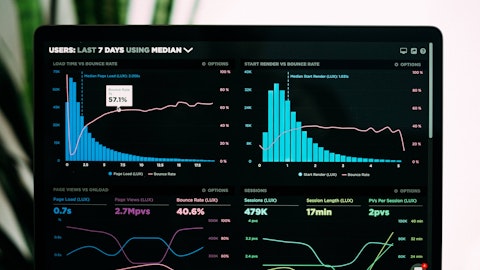Alexia Howard: Okay. So your sales algorithm for 2024 is obviously below where it would normally be at minus 1% to plus 1%. Can you quantify how much of a headwind are these deliberate decisions to exit the DSD business, to divest canning, to exit low-margin business in Europe? We just want to get a sense for how much is you choosing to exit versus what the underlying numbers are?
Mike Smith: Hi, Alexia, yes, it’s around 1% for Q1, but then it really Peters out the rest of the year. So very small the rest of the year. But 1% for Q1 as we lapped the decisions we made last year.
Alexia Howard: Got it. Okay. And then the market share trends in U.S. measured channels are obviously what everybody seems to have their eye on right now. Do you have a view, given your price gap management and the marketing spending investments, the innovation pickup, when we might start to see that improve sequentially and when we might even start to see that turn positive again? Just wondering how long it’s going to take to start to see those benefits in the share line.
Brendan Foley: Well, Alexia, thanks for the question. We never really project exactly what to expect and share, because there’s just a lot of dynamics that might happen at the shelf. But I would point to how we’re talking about volume and our outlook on volume as we think about the first half, the second half and as we expect to kind of grow volume in the back half of the year. That certainly will have an influence on what we see play out in share performance. But we tend not to sort of specifically tell you. I don’t think that there is a specific quarter I can tell you when that’s going to happen.
Alexia Howard: Okay. Thank you. I’ll pass it on.
Operator: Thank you. Our next question comes from the line of Max Gumport with BNP Paribas. Please proceed with your question.
Max Gumport: Hi, thanks for the question. With regard to cadence on the top line, it sounds like you’ve got volume trends that could improve as you go through the year with even growth in the second half. But then you’ve got the impact of last year’s pricing actions which will wane as we go through the year. Would you expect those two factors to roughly offset each other, such that organic net sales growth is relatively consistent through the year? Or is there any net sales cadence we should be keeping in mind? Thanks.
Mike Smith: I mean the pricing, Max, is really focused on the first half a bit more in the first quarter based on the timing of our pricing. I mean, the volume growth is sequential across both segments. And as you know, based on our fourth quarter performance, Flavor Solutions is exiting the year a little better trajectory than — or at least based than Consumer. So as you model those things, you think about sequential improvement to get to that zero to negative two volume growth kind of the first half, second half story. And then pricing is really heavily weighted to the first half, primarily the first quarter.
Max Gumport: Thanks. And then as a follow-up, you’ve characterized your outlook as embedding a more cautious view regarding 2024, a few times now. It sounds like much of that conservatism is around your underlying assumptions on volume. You talked about the value-seeking behavior in the U.S. and flat sales growth in China. But I was hoping you could dive a bit deeper into some of those more cautious use you’re taking and also they’re impacting your gross margin commentary as well? Thank you.
Brendan Foley: Well, good morning, Max, I’ll maybe kick it off with some context around your question on sales and consumption and sort of the state of the consumer, and I’ll pass it over to Mike for commentary on — I think you had a question there with regard to margin. But I think we are taking a cautious view with regard to where the consumer is right now. And that’s really informed by what we saw in Q4. We just saw a little bit more shifting, particularly as you think about how the quarter played out and if you think about consumption trends, we saw consumers really pulled back in September and October, and then really wait until right before the holidays to really make a lot of their purchases. And we even see — saw similar indications leading up to Christmas.
So, what’s underneath that, I think, is people were certainly holding off there, making a lot more trips to the store, buying a lot fewer items and units. And maybe even smaller units actually started to come true, I think, from a consumer trend standpoint. And I think we just have to acknowledge that this is a little bit different than what we saw in the summer. It was a little bit more pronounced. Certainly, it affected our trends as we kind of been really clear about. And so it’s prudent for us to just take a cautious view where the consumer is going to be going here in early 2024. And so we felt like it was best to recognize that in our outlook, particularly as we think about the first half of the year. But we’re also going to be putting in more investment in the business, more A&P.
So we expect also to be able to meet the consumer where they are right now and really try to focus on our game plan, which is to drive volume growth. Mike, do you want to add…
Brendan Foley: Yes. Would you mind repeating the margin question, I didn’t quite get that.
Max Gumport: I was wondering if the conservatism that you discussed that really is just focused on the commentary you just discussed on volumes or if it applies to gross margins as well, that there’s some — more cautious outlook embedded in the gross margin guidance as well?
Brendan Foley: Yes. I mean we’re confident in our CCI and GOE programs. I mean we’ve baked — low single-digit inflation environment, like I said before, which we have good line of sight generally for the rest of the year, gives us more confidence there. First quarter is going to be our highest cost increase. And we see it petering down after that and our pricing is going to be the highest in the first quarter, too. Generally, I think what I’d say, if you think about last year with our GOE programs, we met our targets. Actually, we exceeded a bit our external targets. We were a bit prudent because — but we met our internal target. So I would say being prudent is the word of the day. And love to over-deliver if we could. But we also realized in this environment, making investments on price gap management and A&P is really important. So we’ll assess that as the year goes on.
Max Gumport: Great. Thanks very much.
Operator: Thank you. Our next question comes from the line of Steve Powers with Deutsche Bank. Please proceed with your question.
Steve Powers: Hi. Thanks very much.
Brendan Foley: Good morning Steve.
Steve Powers: So — good morning. So it sounds like at the enterprise level, pretty minimal pricing in the back half. I think that implies, as I listened to the commentary and kind of do the math and think about the price gap management, I think that implies negative pricing in the Consumer business at least in the U.S. in the back half. I wonder if you can talk about that, how deep those kind of above-the-line investments may need to be or how you’re thinking about that. And whether there’s a risk that at the enterprise level pricing actually, this negative, as we flow through the year in pursuit of this volume recovery.





